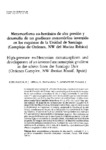Mostrar o rexistro simple do ítem
Metamorfismo eo-hercínico de alta presión y desarrollo de un gradiente metamórfico invertido en los esquistos de la Unidad de Santiago (Complejo de Ordenes, NW del Macizo Ibérico)
| dc.contributor.author | Rubio Pascual, F. J. | |
| dc.contributor.author | Arenas, Ricardo | |
| dc.contributor.author | Díaz-García, F. | |
| dc.contributor.author | González del Tánago, J. | |
| dc.date.accessioned | 2010-01-22T13:21:31Z | |
| dc.date.available | 2010-01-22T13:21:31Z | |
| dc.date.issued | 1993 | |
| dc.identifier.citation | Cadernos do Laboratorio Xeolóxico de Laxe, 1993, 18: 37-45 ISSN: 0213-4497 | es_ES |
| dc.identifier.issn | 0213-4497 | |
| dc.identifier.uri | http://hdl.handle.net/2183/6150 | |
| dc.description.abstract | [Resumen] La evolución tectonotermal de la Unidad de Santiago, situada en el margen occidental del Complejo de Ordenes, está caracterizada por el desarrollo de un episodio de metamorfismo eo-hercínico de alta -P y baja a intermedia -T. Las condiciones P-T para las paragénesis del evento de alta presión (que se conservan esencialmente como una Si = SI muy fina incluida en porfidoblastos de albita de esquistos semipelíticos) han sido estimadas en 493 ± 9°C y 14,7 ± 0.7 kbar (presión mínima). El desarrollo del metamorfismo de alta presión y la ausencia de reequilibrios significativos en su mineralogía característica, sugiere que la unidad (probablemente un fragmento del margen continental de Gondwana) ha sido elevada inmediatamente después de su subducción en el comienzo de la Orogenia Hercínica. El ascenso sin-F2 de la Unidad de Santiago induce una trayectoria P-T marcadamente descompresiva y ligeramente prograda. Esta trayectoria sugiere muy probablemente que la mayor parte de la historia ascensional de la unidad tuvo lugar en un contexto de extensión dúctil, relacionada con la subducción progresiva del margen continental de Gondwana y el desarrollo contemporáneo de extensión compensatoria por encima. La disposición actual de las zonas metamórficas sin-F2 es inversa, con la zona de la estaurolita (que representa el pico térmico) ocupando el techo de la unidad. | |
| dc.description.abstract | [Abstract] A high-pressure-Iow to intermediate-temperature eo-Hercynian metamorphic event characterizes the tectonothermal evolution of the Santiago Unit, in the western margin of the Ordenes Complexo P-T conditions for the mineral assemblages of the high-pressure event (wich is essentially preserved as a very thin Si =SI included in albite porphyroblasts from semipelitic schists) have been estimated at 493 ± 9°C and 14.7 ± 0.7 kbar (minimum pressure). The development of the high-pressure metamorphism and the lacking of significative reequilibrium of their characteristic mineralogy, suggests that the unit (probably a fragment of the continental margin of Gondwana) has been uplifted inmediately after undergoing subduction in the beginning of the Hercynian Orogeny. The syn-D2 uplift of the Santiago Unit cause a markedly decompressive-slightly prograde P-T path. This path very likely suggests that the majority of the rising history of the unit took place in a context of ductile extensión, related to the continued underplating of the continental margin of Gondwana and compensating extension aboye. The actual disposition of the syn-D2 metamorphic zones is inverse, with the staurolite zone (which represents the thermal peak) occupying the top of the unit | |
| dc.language.iso | spa | es_ES |
| dc.publisher | Universidade da Coruña | es_ES |
| dc.subject | Metamorfismo co-hercínico de alta presión | es_ES |
| dc.subject | Evolución P T t | es_ES |
| dc.subject | Gradiente metamórfico invertido | es_ES |
| dc.subject | Complejos alóctonos | es_ES |
| dc.subject | Galicia | es_ES |
| dc.subject | NW Macizo Ibérico | es_ES |
| dc.subject | High-pressure eo-Hercynian metamorphism | es_ES |
| dc.subject | T evolution | es_ES |
| dc.subject | Inverted metamorphic gradient | es_ES |
| dc.subject | Allochtonous Complexes | es_ES |
| dc.title | Metamorfismo eo-hercínico de alta presión y desarrollo de un gradiente metamórfico invertido en los esquistos de la Unidad de Santiago (Complejo de Ordenes, NW del Macizo Ibérico) | es_ES |
| dc.title.alternative | High-pressure eo-Hercynian metamorphism and development of an inverted metamorphic gradient in the schists from the Santiago Unit (Ordenes Complex, NW Iberian Massif, Spain) | |
| dc.type | info:eu-repo/semantics/article | es_ES |
| dc.rights.access | info:eu-repo/semantics/openAccess |






